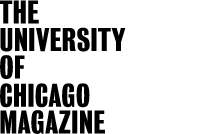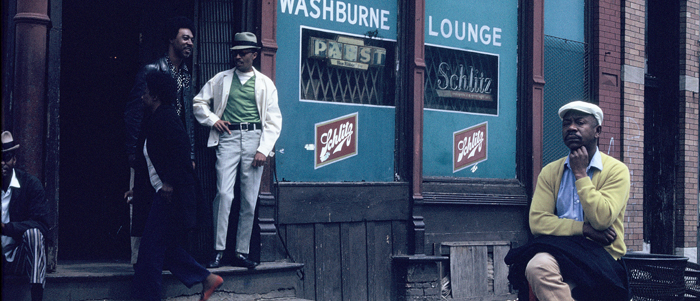Lou Fourcher, PhD'71, came to Chicago from a Massachusetts fishing village, by way of Maine's Bowdoin College, to study psychology. He wanted to see inside people, to understand the forces that shaped them. His curiosity extended beyond his own cultural experience: as an undergraduate in the mid-1960s, Fourcher spent a semester at Atlanta's historically black Morehouse College.
In 1971 he took his interest in people and his Pentax 35 mm camera into Chicago's Near West Side neighborhood known as the Valley. Now the area encompasses the Illinois Medical District, the site of the new Cook County Hospital, Rush University Medical Center, and the University of Illinois at Chicago health-sciences campus. Before the medical development displaced many residents, the Valley was a vibrant, if troubled, neighborhood. Flamboyant neon, polyester fashions, and static-electric Afros date Fourcher's images of the vanished community, yet they feel like the present tense. "Because they show soul," says his son Mike Fourcher.
That's what Lou Fourcher went looking for with his camera. While working for UIC's Valley Project, which included a health clinic, he befriended a gang member whose protection gave him access to parts of the neighborhood where he otherwise might not have been welcome. "My dad described this guy walking around showing his gun to people," Mike Fourcher says. He also captured candid and intimate moments in private homes. "I don't know how my father managed to be a part of these people's lives."
Now suffering from Alzheimer's and living in a Rogers Park facility, the 68-year-old Fourcher no longer remembers many details about the people from the Valley—and even when he did, he didn't talk much about them. He still has some images framed on his wall and recognizes them as his work, but the disease has robbed him of the details. Last winter Mike Fourcher, the publisher of two online North Side publications, the Center Square Journal and Roscoe View Journal, turned to technology to help satisfy his curiosity about the photos.
Scanning 300 slides that filled three carousels in a basement closet, he created a public Flickr stream. Almost 6,000 page views later, he has accumulated colorful nuggets in the form of online comments, and he's tapped into nostalgia expressed in emoticons and exclamation points: "omg look at my uncle bunky :)" "What memories!!!"
Former Valley resident Bill Roddy, whose memoir Manhood from the Hood (Beaver's Pond Press, 2010) recounts his experiences there, recognized childhood buddies Fat Jaw, Chuckie, and Mickie Williams clowning for the camera in a few shots. In another, Roddy identified his friend Jerry McDonald leaning against a graffiti-sprayed wall. "We were young 'pool sharks' at the Y," Roddy writes under his Flickr handle M_Sincerely. "We both use to 'run' the tables after school. The older youth and adults hated us because we were very good at shooting pool at a very young age."
There are photos of the adults playing pool on a duct-taped table beneath sketches of Martin Luther King Jr., Thurgood Marshall, and Sidney Poitier. Others show men hanging out on stoops and street corners or kids playing baseball, riding bikes, swinging at a playground. Shops, bars, churches—the Sunrise Grocery, the Washburne Lounge, the Timmons Holy Temple—all have scissor gates protecting their windows and doors. Boarded-up buildings and brick walls spray painted with true love and gang messages pock the landscape. Behind a fence, a menacing snout looms above a sign that reads, "Beware of Bad-Dog."
Amid the blight, bright life shines. Groups of kids play on porches, in vacant lots, in alleys. High-school-age girls preen for the camera. Another group of girls waits for a bus at a Roosevelt Road stop, resplendent in bright red, yellow, and blue coats. A commenter on Fourcher's Flickr stream speculates that they probably attended Simpson High School, where pregnant girls were sent. "And if you take a look, they're pregnant," says Fourcher, who hadn't noticed that before.
Other details are hard to miss, like the YMCA employee in red, white, and blue striped pants and an American flag hat. Or, Fourcher notes, "the young woman who is clearly trying to be all sexy, but her outfit just makes her look like Santa Claus. What's that all about?"
Those what-were-we-thinking embarrassments scream 1970s, but a poignant thread runs through the photos. From babies to grandparents, Lou Fourcher documented ordinary lives that otherwise could have been lost to history. "It's a neighborhood that no longer exists," Mike Fourcher says, "and a neighborhood where people really didn't have the means to take a lot of pictures."
The photos have gotten the old neighbors reminiscing about people and places—the market offering five loaves of bread for a dollar, the dank interior of Ms. Mary Sweet Shop, the working men who tinkered with their cars to race on the weekends. "My father was always interested in unflinching truth and interested in the soul of people," Mike Fourcher says. His psychologist's mind and photographer's eye revealed the soul in the Valley.






 Slide Show
Slide Show



